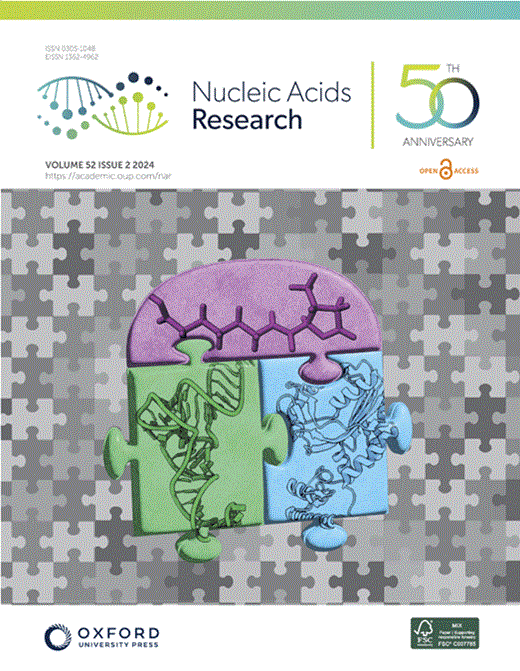The ABCF ATPase New1 resolves translation termination defects associated with specific tRNAArg and tRNALys isoacceptors in the P site
IF 16.6
2区 生物学
Q1 BIOCHEMISTRY & MOLECULAR BIOLOGY
引用次数: 0
Abstract
The efficiency of translation termination is determined by the nature of the stop codon as well as its context. In eukaryotes, recognition of the A-site stop codon and release of the polypeptide are mediated by release factors eRF1 and eRF3, respectively. Translation termination is modulated by other factors which either directly interact with release factors or bind to the E-site and modulate the activity of the peptidyl transferase center. Previous studies suggested that the Saccharomyces cerevisiae ABCF ATPase New1 is involved in translation termination and/or ribosome recycling, however, the exact function remained unclear. Here, we have applied 5PSeq, single-particle cryo-EM and readthrough reporter assays to provide insight into the biological function of New1. We show that the lack of New1 results in ribosomal stalling at stop codons preceded by a lysine or arginine codon and that the stalling is not defined by the nature of the C-terminal amino acid but rather by the identity of the tRNA isoacceptor in the P-site. Collectively, our results suggest that translation termination is inefficient when ribosomes have specific tRNA isoacceptors in the P-site and that the recruitment of New1 rescues ribosomes at these problematic termination contexts.ABCF ATP 酶 New1 解决了与 P 位点中特定 tRNAArg 和 tRNALys 异接受者有关的翻译终止缺陷
翻译终止的效率取决于终止密码子的性质及其上下文。在真核生物中,A 位点终止密码子的识别和多肽的释放分别由释放因子 eRF1 和 eRF3 介导。翻译终止受其他因子的调节,这些因子或直接与释放因子相互作用,或与 E 位点结合并调节肽基转移酶中心的活性。以前的研究表明,酿酒酵母 ABCF ATPase New1 参与了翻译终止和/或核糖体再循环,但其确切功能仍不清楚。在这里,我们应用了 5PSeq、单颗粒低温电子显微镜和读穿报告实验来深入了解 New1 的生物学功能。 我们发现,缺乏 New1 会导致核糖体在以赖氨酸或精氨酸密码子为前缀的终止密码子处停滞,而且这种停滞并不是由 C 端氨基酸的性质决定的,而是由 P 位点中 tRNA 异位接受者的身份决定的。总之,我们的研究结果表明,当核糖体的 P 位点有特定的 tRNA 同位受体时,翻译终止的效率很低,而 New1 的招募能在这些有问题的终止情况下挽救核糖体。
本文章由计算机程序翻译,如有差异,请以英文原文为准。
求助全文
约1分钟内获得全文
求助全文
来源期刊

Nucleic Acids Research
生物-生化与分子生物学
CiteScore
27.10
自引率
4.70%
发文量
1057
审稿时长
2 months
期刊介绍:
Nucleic Acids Research (NAR) is a scientific journal that publishes research on various aspects of nucleic acids and proteins involved in nucleic acid metabolism and interactions. It covers areas such as chemistry and synthetic biology, computational biology, gene regulation, chromatin and epigenetics, genome integrity, repair and replication, genomics, molecular biology, nucleic acid enzymes, RNA, and structural biology. The journal also includes a Survey and Summary section for brief reviews. Additionally, each year, the first issue is dedicated to biological databases, and an issue in July focuses on web-based software resources for the biological community. Nucleic Acids Research is indexed by several services including Abstracts on Hygiene and Communicable Diseases, Animal Breeding Abstracts, Agricultural Engineering Abstracts, Agbiotech News and Information, BIOSIS Previews, CAB Abstracts, and EMBASE.
文献相关原料
| 公司名称 | 产品信息 | 采购帮参考价格 |
|---|
 求助内容:
求助内容: 应助结果提醒方式:
应助结果提醒方式:


